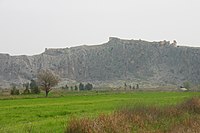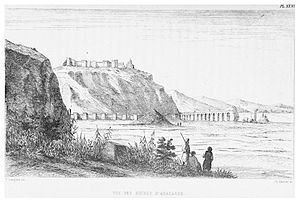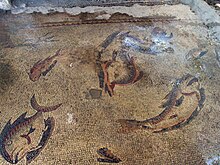Anazarbos
Anazarbos , Latin Anazarbus , is an ancient city in northeastern Cilicia (Kilikia Pedias) (today in the province of Adana , Turkey ). Other forms of name are: Anarzabus , Anazarba , Caesarea ad Anazarbum , Justinianopolis , in post-ancient times Anazarva , ʿAin Zarba (Arabic), Naversa (crusader), Çeçen Anavarza , today Ağaçlı or Dilekkaya (" wishing rock "). The name is derived from a legendary founder of the same name or from a mountain nearby. The "Anavarza rock" is often mentioned in works by the writer Yaşar Kemal , such as " Memed my falcon " and "The herb of immortality". Today the small village of Dilekkaya exists on the edge of the extensive ruins of Anazarbos .
The city was a metropolitan bishopric in the area of the Patriarchate of Antioch and is now a titular archbishopric of the Roman Catholic Church (see titular archbishopric Anazarbus ).
location
Anazarbos is located 28 km south of Kozan (Sis) in the province of Adana on the river Ceyhan (ancient Pyramos). Due to its over 200 m high castle hill, an offshoot of the Taurus , which protrudes into the Cilician plain, the fortification there was of great strategic importance throughout ancient times.
history
According to the first excavation results, the castle hill was already settled in prehistoric times. The city has been through coinage since the 2nd century BC. Occupied. 67 BC The former pirate Tarkondimotos I was appointed king of Anazarbos by Pompey . He died in the naval battle of Actium , where he fought on the side of Mark Antony . After the death of King Tarkondimotos II , Rome took over direct rule. The settlement received 19 BC. BC from Augustus the city rights and was incorporated into the Roman Empire shortly afterwards. In 260 AD, Anazarbos was conquered by the Sassanid king Shapur I. The saints Tharakos , Probus and Andronikos suffered martyrdom in Anazarbos around 304 and were then considered the patron saints of Cilicia. Their relics were finally transferred to Mopsuestia by Bishop Auxentius .
Around 380 the city was devastated by the Isaurian bandit Balbinus . Under Theodosius II , Anazarbos became the capital of the province of Cilicia Secunda. Councils were held here in 431 and 435 . A titular archbishopric of the Roman Catholic Church existed until the 20th century. The city was destroyed by earthquakes in 525, 561 and 1945, and plagued in the 6th century. After being destroyed by a devastating earthquake that devastated all of Cilicia, the city was rebuilt under Justin I and given the name Iustinopolis .
The Abbasid Hārūn ar-Raschīd rebuilt the city in 796 and the Caliph al-Mutawakkil (846-861) had buildings erected here, as evidenced by Kufic building inscriptions in a tower at the west gate. Under Basil I (867-886) Abu Abdallah ibn Amr is mentioned as the Emir of Anazarba. Allegedly he left the city on the news that an imperial army was approaching and fled to Melitene , but nothing is reported of an capture of Anazarba by the Byzantines. In the 10th century the Hamdanid Saif ad-Daula had the city fortified for (as Yaqut reports) three million dirhams .
964 Nikephorus II Phocas conquered the city. After it fell to the Armenian Thoros I in 1107 , it was re-conquered under John II Comnenus between 1137 and 1144. It was the capital of Lesser Armenia until 1184 , when Tarsus became the capital.
Research history
The ruins were visited by Charles Texier in 1836 . The French orientalist Victor Langlois was there from 1852–53 to study inscriptions and structural traces from the time of the Armenian Kingdom. The British traveler Gertrude Bell also visited Anazarbos. The German Archaeological Institute has carried out a survey here since 2004 .
Attractions
- City wall 1.5 km long, with four goals and 20 bastions equipped
- Boulevard
- Thermal baths
- theatre
- Stadium outside the city walls
- aqueduct
- Ruins of the Apostle Church
- Arched monument with three passages, the south side is adorned with six Corinthian columns made of black granite . On the north side there are niches with statues.
- Necropolis in the west of the city, rock chamber tombs and free-standing sarcophagi
- Medieval castle with three defensive walls, barracks, a three-story tower, storehouses and cisterns.
- A 250 m long, 4–15 m deep gorge in which the road from Anazarbos to Flaviopolis ( Kozan ) and Hierapolis Kastabala runs. According to legend, it was created by Ali ibn Abi Talib when he split the rock with his sword while fleeing from his enemies.
- In the local open-air museum, mosaics, including of fish, and various components such as capitals can be seen.
Historical personalities
- St. Julianus of Anazarbos († 302), feast day March 16, was born in Anazarbos and suffered martyrdom under Diocletian when he was thrown into the Mediterranean in a sack full of snakes and scorpions. His relics are kept in Antakya .
- the Roman physician and naturalist Dioscurides from the 1st century AD. His main work, De materia medica , was written between 50 and 70 AD.
literature
- Victor Langlois : Voyage dans la Cilicie et dans les montagnes du Taurus: Execute pendant les années 1851-1853 ... . B. Duprat, Paris 1861 at Google Books
- Michael Gough : Anazarbus . In: Anatolian Studies 2, 1952, pp. 85-150.
- Michael Gough: Anazarbos Cilicia Campestris, Turkey . In: Richard Stillwell et al. a. (Ed.): The Princeton Encyclopedia of Classical Sites. Princeton University Press, Princeton NJ 1976, ISBN 0-691-03542-3 .
- Paolo Verzone: Città ellenistiche e romane dell'Asia Minore: Anazarbus . In: Palladio NS 7, 1957, pp. 9-25.
- Friedrich Hild , Hansgerd Hellenkemper : Kilikien und Isaurien , Tabula Imperii Byzantini 5, Vienna 1990, pp. 178-185, ISBN 3-7001-1811-2
- Hansgerd Hellenkemper : The city walls of Anazarbos / Ayn Zarba . In: 24th German Orientalist Day from September 26th to 30th, 1988. Selected lectures . Steiner, Stuttgart 1990. pp. 71-76. ISBN 3-515-05356-5 .
- Ruprecht Ziegler : Emperor, Army and City Money. Investigations into the coinage of Anazarbos and other East Kilikian cities . Vienna 1993 (supplementary volumes to the Tituli Asiae Minoris, 16) ISBN 3-7001-2001-X .
- Mustafa Hamdi Sayar: The inscriptions from Anazarbos and the surrounding area . Part 1. Inscriptions from the urban area and the immediate vicinity of the city . Habelt, Bonn 2000 (inscriptions of Greek cities from Asia Minor, 56) ISBN 3-7749-2960-2 .
- Richard Posamentir, Mustafa Hamdi Sayar: Anazarbos. An interim report from the metropolis of the Plains Cilicia. In: Istanbuler Mitteilungen 56, 2006, pp. 317–357.
- Richard Posamentir: Without measure and aim? Remarks on the colonnaded street of Anazarbos in the Cilicia Plain. In: I. Delemen et al. (Ed.): Festschrift for Haluk Abbasoğlu on the occasion of his 65th birthday in 2008. Istanbul 2008, pp. 1013-1033
- M. Kadıoğlu, Anazarbos Zafer Takı: Restitüsyon ve Tarihleme Önerisi . In: G. Kökdemir (ed.), Orhan Bingöl'e 67. Yaş Armağanı / A Festschrift for Orhan Bingöl on the occasion of his 67th birthday (2013) 237–260.
- Richard Posamentir: Anazarbos in Hellenism. In: A. Hoffmann; R. Posamentir; MH Sayar (ed.): Hellenism in the Cilicia Pedias . BYZAS 12 (2011) online
Web links
- University of Tübingen project: survey processing
- Bibliography on Anazarba, English works ( Memento from September 29, 2007 in the Internet Archive )
- Research by the German Archaeological Institute ( Memento from September 29, 2007 in the Internet Archive )
Coordinates: 37 ° 15 ′ 50 ″ N , 35 ° 54 ′ 20 ″ E



